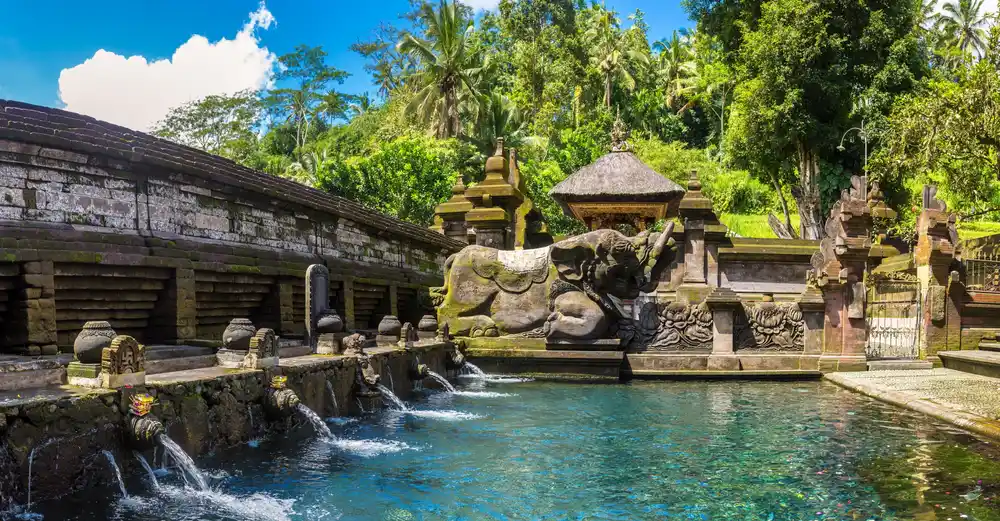Bali is an Indonesian province and island in the westernmost end of the Lesser Sunda chain. It spans5780km2 between Java and Lombok and is dominated by volcanic mountains such as Mount Agung. Its name may derive from the Sanskrit word “Wali” meaning offering or from Bali, the mythic Javanese hero. Bali has about4360000 residents. Bahasa Indonesia is the official language; Balinese is spoken in villages and English is common in tourist areas. Alcohol is sold in licensed bars from age21; narcotics are forbidden and carry severe penalties. Gambling is illegal outside hotel slot machines; no casinos operate. Bali’s highest authority is Indonesia’s President, represented locally by a Governor. Defense and security are provided by the Indonesian National Armed Forces and National Police under central command.
History
Human presence on Bali dates to at least2000BCE when Austronesian settlers arrived bringing rice cultivation and pottery. By1A thousand years later Balinese society was organized into small kingdoms ruled by hereditary rajas. Early inscriptions and temple sites attest to Hindu-Buddhist influence from Java and India. In8A century the ancient kingdom of Pejeng built megaliths and established close ties with Java’s Sailendra and Warmadewa dynasties. The legendary QueenMahendradatta married a Javanese prince and her son Airlangga became a great ruler of East Java, cementing cultural exchange.
From10A to14A centuries the Warmadewa and later Majapahit dynasties controlled Bali through vassal rajas. The Majapahit brought Javanese Hindu culture and architecture, visible in cliffside palace ruins near Uluwatu. Local lords adopted complex irrigation management known as subak, a cooperative system still in use and recognized as a UNESCO Cultural Landscape in2012.
In16A century the first European visitors arrived: Portuguese sailors charted the coast and traded spices. By17A century Dutch influence expanded under the Dutch East India Company which imposed trade monopolies. Balinese rajas resisted colonial control, leading to a series of “Puputan” mass ritual suicides in1906 and1908 at Denpasar and Klungkung when Dutch forces advanced. Thousands of Balinese perished rather than submit to foreign rule.
In1942 Japanese forces occupied Bali during World War II, displacing Dutch administrators and disrupting local life. After Japan’s surrender in1945 Indonesian nationalists declared independence. Bali became part of the Republic of Indonesia in1949 following the Dutch–Indonesian Round Table Conference. Western visitors began arriving in the1950s and1960s, drawn by surfing prospects and exotic culture.
The 1965–1966 anti-Communist purge reached Bali, with thousands killed or imprisoned in political violence. Suharto’s New Order regime centralized power and promoted tourism as a key economic driver. In1976 the Pura Besakih volcano eruption threatened villages but caused fewer casualties than feared due to effective evacuations.
The1980s saw rapid tourist growth and infrastructure development including Ngurah Rai International Airport. Bali’s cultural identity was commercialized through arts markets and entertainment venues. In2002 and2005 Bali was rocked by terrorist attacks in Kuta, killing over200 people and severely impacting tourism. Resilience and global solidarity spurred recovery, with visitor numbers rebounding within two years.
In2017 Mount Agung erupted, causing flight suspensions and evacuations of over100000 residents. The island’s volcanic richness, however, replenished rice terraces and cultivated soils. The COVID-19 pandemic in2020 closed Bali to visitors for over a year, devastating the tourism sector. Government stimulus and community initiatives revived domestic travel and small enterprises.
Today Bali balances tourism with cultural and environmental preservation. Local leaders implement sustainable tourism measures, subak water management continues to shape landscapes, and spiritual traditions remain central. The island’s history of kingdom rivalry, colonial resistance and modern adaptation has forged a society resilient and proud of its heritage.
Industry
Bali’s economy centers on tourism arts agriculture and small-scale manufacturing. It is the birthplace of ultravinegar-infused tropical jam brand “UbudJelly” and surfwear label Quiksilver’s Indonesian headquarters. Local luxury spa and wellness brands such as Six Senses and COMO have world-class resorts here. Bali has set industrial records in handcrafted silver jewelry exports and batik textile production. The organic coffee brand Kopi Luwak has global renown—made from beans digested and excreted by civets—though sustainability concerns grow.
Religion and Ethnicities
Approximately83 percent of Balinese identify as Balinese Hindu, following Agama Hindu Dharma religion blending Shaivism Buddhism and local ancestor worship. Muslims13 percent practice Sunni Islam, mainly migrants from Java. Christians and Buddhists comprise the remainder. Ethnically the population is98 percent Balinese with Javanese and foreign expatriates making up2 percent. Daily offerings (canang sari) to spirits and gods at temples and family shrines are a ubiquitous tradition.
Wars and Conflicts
Inter-kingdom conflicts from10A to19A centuries shaped Bali’s political landscape; numerous princely states vied for power. The Dutch colonial wars in1906–1908 ended local sovereignty with violent Puputan. Japanese WWII occupation in1942–1945 led to forced labor and famine. During Indonesia’s post-independence political violence in1965–1966 thousands accused of communism were killed or detained. Bali has no current military conflicts though it contributes national troops to United Nations peacekeeping missions. Several WWII graves and memorials lie near Gianyar and Tabanan.
Standard of Living
Bali’s per-capita GDP is lower than Java’s but above most Indonesian provinces due to tourism revenue. The HDI for Bali Province is0.735, ranking in the medium human development category. Corruption Perceptions Index places Indonesia at121 of180 in2021, while Bali’s localized governance efforts have reduced petty corruption in tourism licensing.
Medicine
Bali has modern private hospitals—Siloam Bali and BIMC Hospital—offering international standards. Public clinics (Puskesmas) provide basic care but may lack equipment. Pharmacies in tourist areas open daily08:00–22:00; rural villages rely on kiosks selling over-the-counter meds. Tourists should carry travel insurance, vaccination for hepatitis A and typhoid recommended. Dengue fever is endemic; use mosquito repellent and nets. Tap water is not potable; drink bottled or filtered water.
Sport
Surfing dominates coastal areas; the Rip Curl Cup on Uluwatu draws international talent. Bali hosts the annual Kiteboarding World Cup in Sanur. Football is popular locally with Perseden Denpasar club. Traditional sports like cockfighting and water buffalo races attract smaller crowds. Bali has no independent Olympic team; Balinese athletes compete for Indonesia in badminton, weightlifting and martial arts.
Holidays
Galungan marks the victory of dharma over adharma, celebrated every210 days on the Balinese Pawukon calendar; penjor bamboo poles line roads, and temples host elaborate ceremonies. Kuningan follows10 days later with offerings and dances. Nyepi, the Day of Silence, falls in March; airports close and the island observes 24-hour silence and no flights, fires or entertainment. Saraswati Day honors the goddess of learning with book blessings. Tumpek Landep and Tumpek Kandang honor iron tools and animals with temple offerings.
Traditions
Balinese host purity rituals with daily offerings of flowers rice and incense placed at shrines. Visitors should remove shoes and cover shoulders and knees when entering temples and family compounds; women in menstruation avoid temple visits. Use the right hand for greeting and passing items. During Nyepi no movement outside residences is permitted; tourists must comply or risk fines.
Interesting Facts
Bali’s subak irrigation system is a UNESCO Cultural Landscape. The Bali bombings in2002 killed over200 people and reshaped security policies. Actor Julia Roberts filmed Eat Pray Love scenes in Ubud in2010. Nobel laureate Rudyard Kipling honeymooned here in1914. Mount Agung’s eruptions in2017 disrupted international flights. Bali Myna bird breeding programs near Bedugul aim to prevent extinction. The Blue Fire phenomenon at Ijen crater on East Java draws Indonesian tourists.
Money
The Indonesian rupiah (IDR) is the currency. ATMs and currency exchanges are widespread in Denpasar Canggu and Ubud. The rate fluctuates around15000IDR per USD. Cash is preferred for small purchases; credit cards accepted in upscale hotels and restaurants. Exchange at banks yields better rates; avoid street changers. Tipping is not obligatory but rounding up bills or leaving5–10percent is appreciated in restaurants and spas.
Household Details
Electricity is230V at50Hz; plugs typesC andF are common. Mobile coverage by Telkomsel XlAxis Indosat and Tri offers 4G. Free Wi-Fi is available in cafes and hotels. Tap water is nonpotable; bottled or filtered water is essential.
Clothing
Lightweight breathable fabrics are ideal. In temples cover shoulders and knees; sarongs and sashes are often provided. At beaches shorts and bikinis are acceptable on the sand but a cover-up is recommended for nearby villages. Closed-toe shoes are advisable for temple tours. Sun hats and sandals with closed toes help navigate uneven ground.
Tourism
A comprehensive Bali visit requires10–14 days. Start in South Bali with Kuta for surfing and nightlife, Seminyak for upscale shopping and Jimbaran for seafood. Spend2–3 days in Ubud exploring rice terraces, temples and art markets. Allocate1 day to Mount Batur sunrise trek and hot springs. Plan2–3 days in East Bali visiting Tirta Gangga, Lempuyang Gates and Amed for wreck diving. Reserve1–2 days in North Bali for Lovina dolphin tours and Gitgit Waterfall. Finish with2–3 days on Nusa Penida or Nusa Lembongan for dramatic coastal cliff hikes and snorkeling. Internal flights, ferries and private drivers facilitate travel.
Types of Tourism
Cultural tourism at temples dance performances and crafts villages. Beach tourism on Kuta Seminyak Canggu and Sanur. Eco-tourism in rice terrace landscapes and waterfalls. Adventure tourism with surfing diving trekking and paragliding. Wellness tourism with yoga retreats and spas. Religious tourism during Nyepi and temple festivals.
List of Tourist Attractions
Pura Besakih – main Mother Temple on Mount Agung
Tegallalang Rice Terraces – iconic split-level paddies
Uluwatu Temple – cliff-top sea temple with Kecak dance
Monkey Forest Ubud – sanctuary for long-tailed macaques
Tanah Lot – offshore sea temple at sunset
List of Non-Tourist Attractions
Trunyan Village – unique burial rituals on Lake Batur shore
Sembiran – Balinese Brahmin village preserving ancient traditions
Karangasem Traditional Salt Pans – hand-harvested salt beds
PIL’s Agung’s Hidden Caves – local spelunking spots off main roads
Gerokgak Fishing Harbour – early morning catch auctions
Local Cuisine
Babi guling – spit-roasted pig with spice rub
Ayam betutu – slow-cooked chicken meats wrapped in banana leaves
Lawar – mixed vegetable and minced meat salad with coconut
Nasi campur – rice plate with small portions of meat tofu sambal and vegetables
Es kelapa muda – fresh young coconut water served in the shell
Rumarrum and arak are local spirits. Breakfast7–9AM lunch12–2PM dinner6–9PM. Street food hygiene varies; choose crowded warungs under management inspection. Tipping5–10percent is customary in sit-down restaurants.
Why Visit
Bali offers stunning landscapes volcanic mountains rice terrace vistas spiritual culture unique Hindu traditions world-class beaches and an established wellness scene all within a small and accessible island.
Safety for Tourists
Petty crime such as bag snatching occurs in crowded areas; avoid walking alone at night in dark streets. No significant terrorist threat since2002. Watch for aggressive monkeys in forests. Local CCTV covers main tourist zones. Dengue fever and leptospirosis risk during rainy season; use repellent and avoid floodwaters. Balinese are welcoming to all nationalities and races, though modest dress is expected at temples.
Tourist Infrastructure
Luxury resorts and boutique villas span island. Spa and yoga studios offer high standards. Tourist information offices in Denpasar Ubud and the airport speak English and other languages. Public restrooms and signage in English are common in major attractions.
Entry Rules
Most nationalities receive a visa on arrival valid for30 days. Passport must be valid for six months beyond entry. Customs prohibit narcotics fresh meat plants firearms and cash over10000USD without declaration.
Transport
Local transport includes metered taxis ride-hailing apps GoJek and Grab and scooter rentals. Bemos (minivans) serve regional routes. Private drivers are available for full-day excursions. Ferry services connect to Nusa Lembongan Nusa Penida and Java. Tickets can be purchased online or at harbors.
Car
International driving permit recognized. Drive on the left. Scooter accidents are common; wear helmets. No official toll roads on the island. Police checkpoints may inspect papers; bribery is illegal but rare. Blood-alcohol limit is zero. Speed limits are30km/h in towns 60km/h on 2-lane roads. No speed cameras but police patrol. SUVs and motorbikes are recommended for hilly terrain. Fines start at500000IDR.
Noise Regulations
Quiet hours in villages typically run from22:00 to06:00. During Nyepi silence is enforced24hours; violators are fined.
Daily Budget
Budget travel costs300000–500000IDR (20–35USD) per day for hostels local meals and scooter rental. Midrange travel is700000–1500000IDR (50–105USD) per day for private rooms restaurant dining and guided tours. Luxury travel exceeds2000000IDR (140USD) daily.
What Is Not Recommended or Strictly Forbidden
Entering temples without sarong or sash is prohibited. Droning over temples and ceremonies is banned. Public displays of affection at sacred sites are disrespectful. Avoid disrespecting local offerings placed on sidewalks.
Climate
Bali has a tropical monsoon climate with dry season April to October and wet season November to March. Temperatures range23–33°C year-round. Best time for travel isMay to September for minimal rain and low humidity.
Travel Tips
Ensure routine vaccinations and consider hepatitis A typhoid and Japanese encephalitis vaccines for rural travel. Use mosquito repellent and netting. Bring a universal adapter and photocopies of documents. Book popular activities and accommodations well in advance. Respect local customs and environmental guidelines to preserve Bali’s natural and cultural heritage. Enjoy your stay!
- Lofoten Islands
- Indians
- Entrance tickets with an open date appeared in the General Staff Building
- Sydney
- Chile
- Borneo
- Win a four-night Greek getaway for two in one of the most stylish resorts in the Aegean courtesy of Sani Resort
- Madagaskar
- Issyk-Kul
- Aztecs
- Distant Storms Create Dangerous Surf at East Coast Beaches
- Tasmania
- Colombia
- Forest Elephants May Return to Nyungwe National Park
- Norway’s Atlantic Road scenic drive
- Holiday in Monaco
- How to Get Around Australia
- Great Plains (USA)
- Everyone says i’m running away
- Pura Vida on the Road: the nuances of traveling Costa Rica












